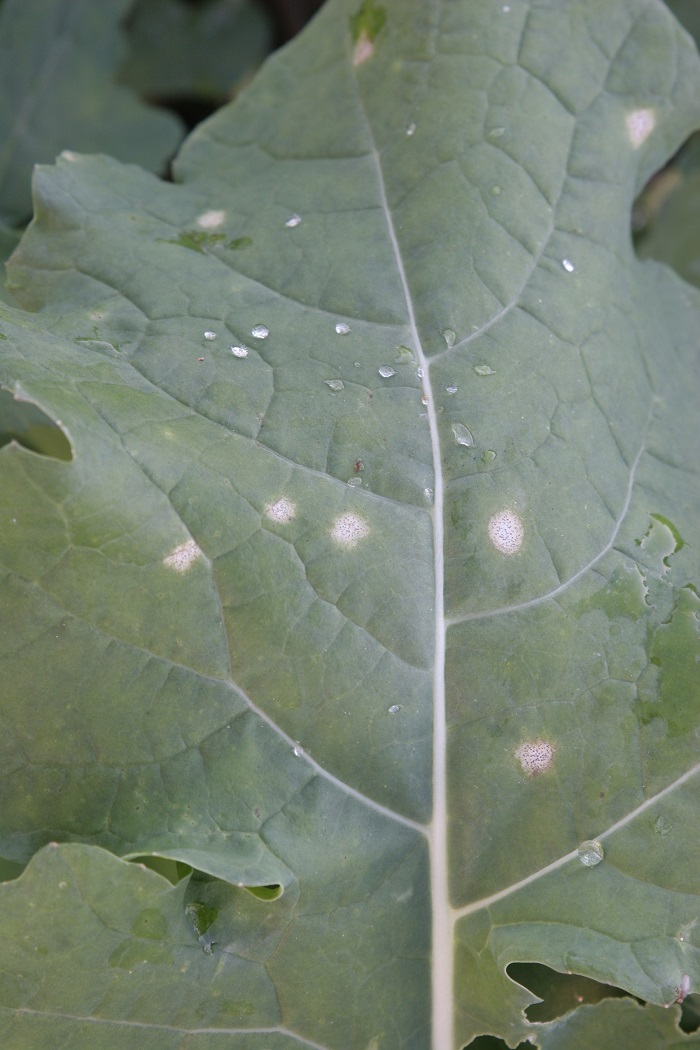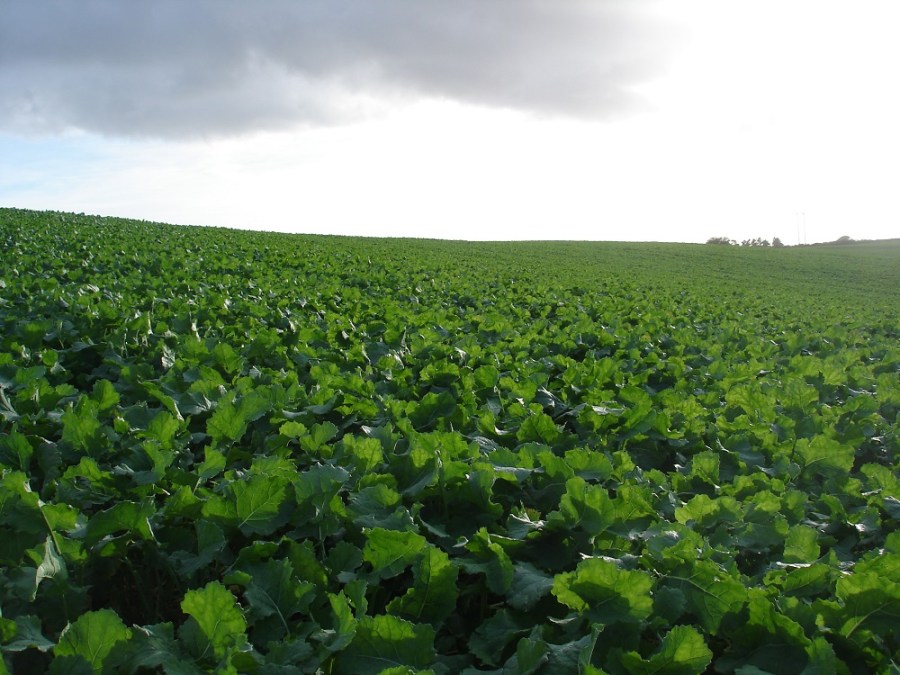Plant host resistance is becoming much relied upon as a way of combatting crop diseases. CPM asks if there’s cause for concern after scientists report the phoma resistance gene Rlm7 is less efficient than it used to be.
Rlm7 is much more complex than the other phoma resistance genes.
By Lucy de la Pasture
Phoma stem canker (Leptosphaeria maculans) resistance in oilseed rape was greatly enhanced by the introduction of the Rlm7 resistance gene in 2001. It’s been almost single-handedly responsible for the improved resistance ratings for phoma now commonplace on the AHDB Recommended List.
It’s proven to be longer-lived than its fellow major resistance genes, but earlier this year a paper was published which showed the Rlm7 gene is less effective than when it was first introduced. So is there cause to worry that it may be breaking down?

The Rlm7 gene reduces early symptoms of phoma stem canker seen in the autumn.
DeKalb were responsible for the very first conventional variety carrying Rlm7 and their breeder, Matthew Clarke is neither surprised nor alarmed by the results of the research carried out by the University of Herts.
“Rlm1 and Rlm4 both broke down within the first three years of being commercially available but Rlm7 is much more complex than the other phoma resistance genes,” he explains.
He’s not surprised by the findings because Rlm7 also seemed to lose some of its efficacy within a few years, but it was only a partial breakdown.
“Varieties with the resistance started showing a small amount of autumn spotting where there had been zero phoma symptoms when it was first introduced,” explains Matthew.
Major resistance genes work by signposting the presence of a pathogen to the plant, so it can employ its natural defences. When this mechanism breaks down, the pathogen changes so that the plant can no longer detect it. This is precisely what the French national research institute, INRA, found when they had a phoma problem in varieties with Rlm7 – the L. maculans population contained isolates that the OSR plant wasn’t able to recognise, explains Matthew.
But they also discovered that isolates with this mutation were less pathogenic, so they aren’t able to attack plants in such a savage way. This helps explain why the early breakdown in efficacy has only ever been partial, he says.
“Also, almost right from the start, DeKalb had a policy of only releasing Rlm7 in hybrid varieties with the resistance on only one parent. Because of this the other parent was able to be chosen for good QR. Commercially we call this ‘Double Phoma Resistance’ but the practical effect has been to give further protection for Rlm7. I think this has also contributed to the longevity of the resistance and the strategy has been borne out by INRA research,” explains Matthew.
“Rlm7 doesn’t behave as a standard single gene resistance so the UK has been a half-way house for years and years as far as any loss in its efficiency.”
The results of the study at University of Herts led by Dr Georgia Mitrousia, confirmed that in the 2012-2013 season, 3% of L. maculans isolates in the UK were virulent against Rlm7 at a time when cultivars with this major resistance gene represented around 5% of the OSR area. Since then the number of varieties grown with the Rlm7 gene has increased significantly, increasing the selection pressure for the L. maculans population to overcome the resistance conferred by the gene.
In France, phoma stem canker is a much bigger problem than in the UK so use of Rlm7 has been widespread, with 50% of the OSR area sown with varieties containing the resistance gene. As a result, 20% of the L. maculans population is now virulent against it after 10 years of use in commercial cultivars. So are we heading in the same direction in the UK?
Dr Vasilis Gegas, head of Limagrain’s oilseeds breeding, believes we’re unlikely to witness a catastrophic breakdown of Rlm7 in the UK for the simple reason that phoma stem canker isn’t as much of an issue as it is in the countries that already have a problem with Rlm7 – France, Canada and Australia.
On the other hand, Vasilis believes the paper is a wake-up call for those that make the decisions regarding varieties for inclusion in National List and RL trials.
“Rlm7 is being widely used by plant breeders because of the obsession for high phoma resistance ratings in new varieties. These genetics are deployed because of this requirement, particularly for the RL, and it skews the breeding,” he says.
“The RL is a route to market for breeders and this is evidenced by the fact that the only two restored hybrids added to the RL in 2017-2018 were rated 8 for phoma resistance, a fact that can only mean the Rlm7 gene has been used, he says.
Vasilis believes that using this major resistance so widely in the UK is potentially asking for trouble, particularly as it’s not necessary to use the big guns in a country where phoma is secondary to light leaf spot in terms of its severity and fungicides are currently very effective against the disease.
Ironically one of the current leading varieties in the French market doesn’t contain Rlm7 but was deemed unsuitable for inclusion in the RL because it didn’t score high enough for phoma resistance, he adds.
“We need to learn from the countries that have already run into problems because they employed the Rlm7 genetics too widely. They have had to bring in a specific deployment strategy to protect their genetics and in France, 25% of varieties must be without it, relying instead on the cumulative effects of minor resistance genes, quantitative resistance (QR).”
Vasilis says the UK should also consider a mix of approaches when it comes to phoma resistance. The germplasm to breed varieties with an effective background resistance already exists, he points out, highlighting conventional varieties which have a phoma resistance rating of 6 or 7 as good examples of this.
“It would be sensible not to deploy varieties dependent on a single major resistance gene on a wide scale, all relying on the same genetics at any one time,” he adds.
Matthew highlights that since the gene was first introduced, it’s raised the bar for phoma resistance as far as the RL is concerned. “The rating system for phoma has become more severe in recent years, so a current variety with a poor phoma rating of 2 or 3 would be equivalent to 5 or 6 in the past. It’s another reason why if there’s ever a complete breakdown in Rlm7, then it probably won’t be a disaster scenario in the UK.”
Both breeders comment that they have a focus on developing strong QR in their new varieties, but there are also other tricks they can employ.
“There are other gene combinations we can use that seem to reverse the part of the process which made the pathogen invisible to the plant’s own defences in the first place,” says Matthew. “Using one of the now defunct Rlm genes in conjunction with Rlm7 has this affect, restoring its full phoma resistance.”
There’s still a lot to understand about the OSR plant’s defence responses to pathogens and the molecular basis of plant resistance. Prof Bruce Fitt’s team of researchers at the University of Herts are attempting to unravel these complex mechanisms, with both phoma stem canker and light leaf spot under investigation.
Throughout agriculture the use of host resistance to aid disease control is becoming ever more important, yet new sources of resistance are often rendered ineffective due to pathogen population changes, explains Dr Henrik Stotz, reading crop protection at the University of Herts.
“One of our projects, led by Dr Yongju Huang, aims to develop new control strategies to increase durability of host resistance. This involves monitoring the emergence of new virulent races of L. maculans and investigating the molecular mechanisms of mutation from avirulence to virulence in the pathogen.”
There’s also an effect of environmental factors (e.g. temperature) on durability of resistance which needs to be understood, he says.
“At higher temperatures the host resistance to phoma stem canker breaks down but we don’t know the molecular basis for this.”
Although phoma stem canker is the more important disease in mainland Europe and other major OSR growing regions of the world, light leaf spot has presented a far greater challenge to British growers in recent seasons, adds Vasilis, particularly as chemistry is also less effective than on phoma.
“Light leaf spot host resistance in OSR varieties is currently all quantitative, relying on the cumulative effect of minor genes. Breeding resistance in to new varieties is difficult because we don’t yet have single gene genetics for light leaf spot, so we have to apply traditional plant breeding techniques,” he explains.
It’s an obvious source of frustration to him that research into phoma receives far more funding than research into light leaf spot. “Funding agencies don’t seem to realise the importance of light leaf spot and we’ve tried and failed to get funding for several research projects. It’s a more challenging pathogen because of its lifecycle, the population can change so quickly,” he adds.
But researchers at the University of Herts are getting close to identifying a major resistance locus for light leaf spot, confirms Henrik, and have now defined an area at the bottom of chromosome A1 within 10 genes of finding the actual resistance gene.
“We haven’t pinpointed it yet, but we think we’re the closest to finding a major gene for light leaf spot resistance and are now going to identify the entire genomic area using long range PCR (polymerase chain reaction), a technique in molecular genetics that permits the analysis of any sequence of DNA.”
When the precise location of this resistance gene has been located then breeders will be able to employ markers, speeding up the breeding process. But it will also assist breeders and researchers help understand resistance loci for other diseases, believes Henrik.
While plant breeders keep the genes used in varieties under wraps, the RL ratings give a good indication of the genetics deployed, points out Vasilis.
“When looking at OSR varieties it’s important not to get too hung up on a particular disease rating, it’s the overall agronomic package that’s important. Single gene genetics for host resistance need to be protected and the best way to do this is not to overuse them,” he concludes.
New herbicide for OSR
A new post-emergence herbicide from Corteva Agriscience, the agricultural division of DowDuPont, has been approved to tackle broad-leaved weeds in OSR. Another member of the Arylex active family of herbicides, Belkar (halauxifen methyl+ picloram) will allow growers to see their crops establish before tackling weeds, helping to manage early-season costs and the risks associated with applying pre-emergence sprays.
John Sellars, Corteva’s OSR herbicide product manager, says Belkar is a game changer because it adds a level of flexibility never seen before in OSR weed control programmes. The spray window for the new herbicide is from Sept to Dec and in extensive field trials it’s shown excellent control of cranesbill, cleavers, poppy, shepherd’s purse, and fumitory.
“Many growers and their advisors have already made their decisions for this autumn’s herbicide applications, so while a limited volume of product will be available for applications this autumn, we are planning to make available and sell the first significant volumes in autumn 2019.”




